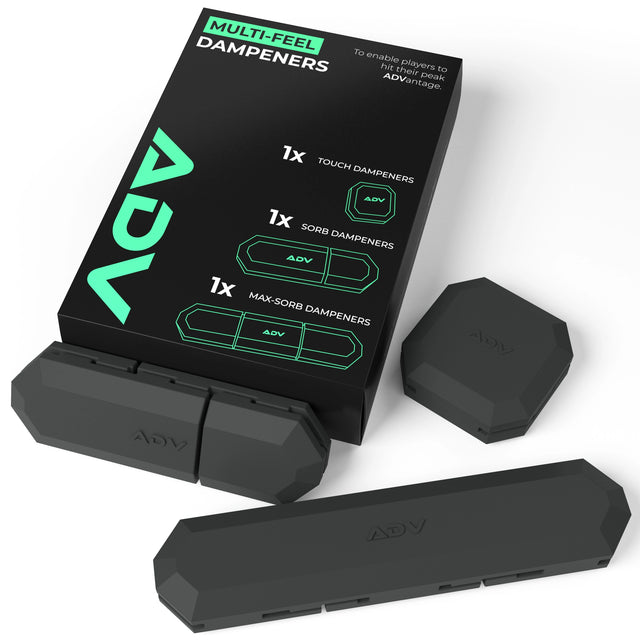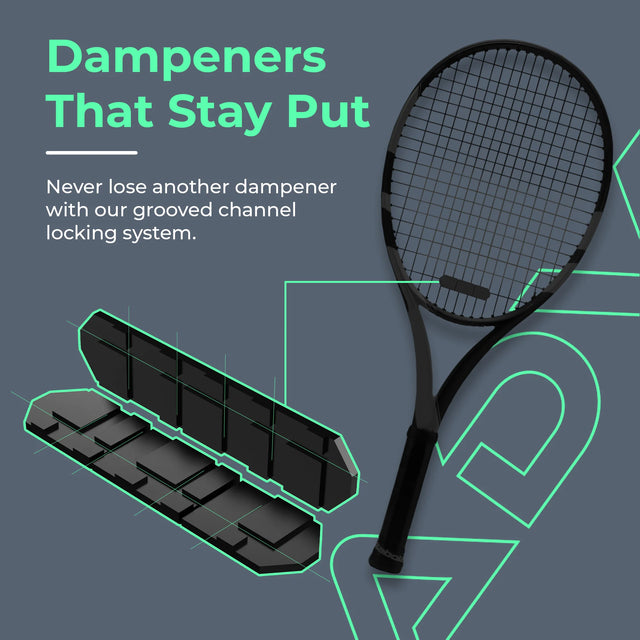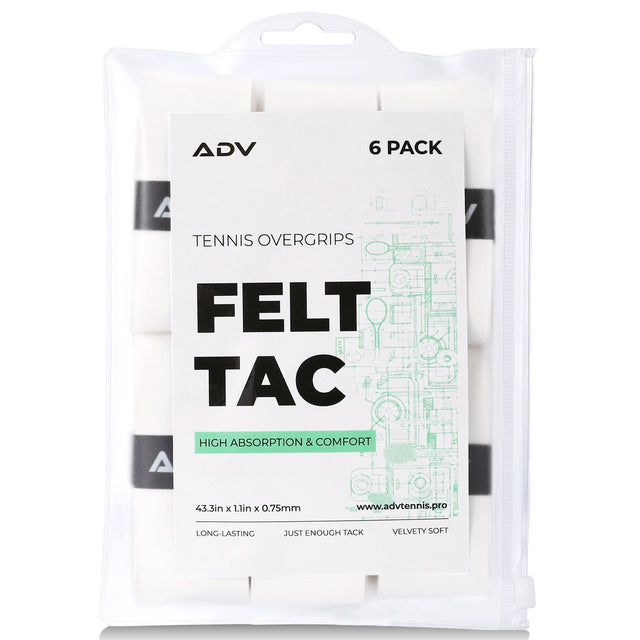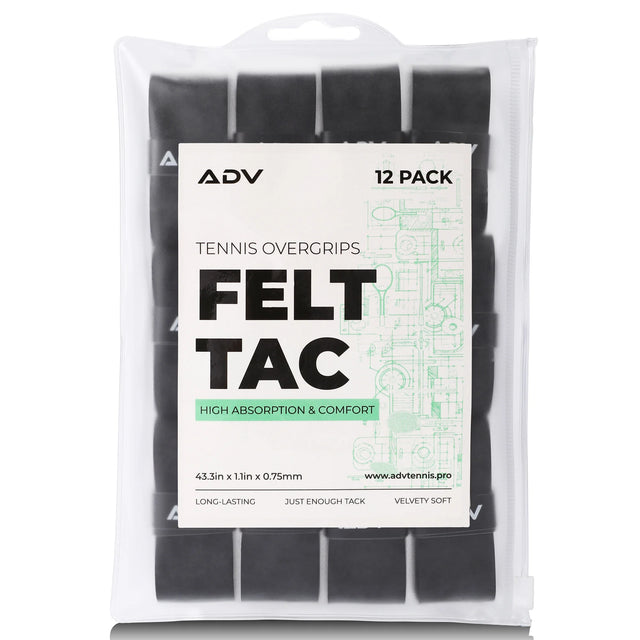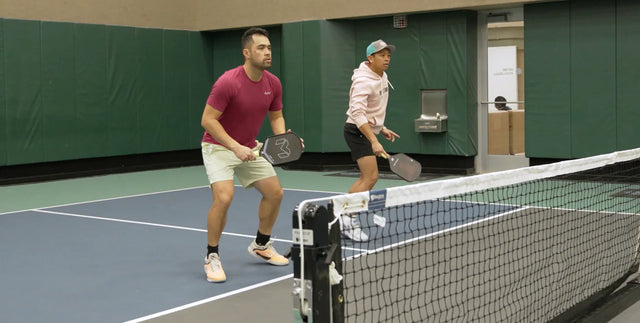Maintaining Tennis Grip Size: Tips for Extended Racket Life
Tennis players often focus on strings, frames, and shoes, but grip size can be just as important. Using the proper grip size for tennis helps you swing freely while maintaining control. If the grip is too small, your hand may overwork, leading to strain or tennis elbow. On the other hand, a grip that's too large can hinder flexibility and reduce wrist movement. Players of all levels should know that grip size affects comfort and performance. It is directly tied to injury prevention and long-term playability. Taking the time to size your grip correctly can significantly impact how you hit the ball and how your body responds during extended matches.
How to Size a Tennis Grip Correctly
Ruler and Index Finger Tests
Finding the right grip size can start with two easy tests: the ruler method and the index finger check. Measure from the bottom lateral crease of your palm to the tip of your ring finger. This number in inches helps determine your ideal grip size. Alternatively, hold a racket in your regular grip and see if your index finger fits snugly between your fingers and palm. This method is quick and helpful when trying different rackets in-store. Knowing how to size a tennis grip accurately helps prevent wrist fatigue and improves control. Always measure with your dominant hand, as slight differences can affect the fit. Both methods give players a reliable way to find their optimal size without needing special equipment.
Signs Your Grip Size Is Too Small or Too Large
A grip that’s too small forces you to grip tighter, which can lead to muscle overuse and even chronic pain. On the other hand, an oversized grip might cause your shots to feel sluggish and reduce your ability to change direction quickly. Other warning signs include visible wear on one side of the grip or uneven calluses on your hand. Fixing grip size can be an easy way to improve your form and overall tennis experience.
Adjustments and When to Make Them
If you’ve recovered from an injury, started using a different stroke technique, or switched playing styles, it might be time to adjust. You can increase or decrease thickness by changing grip materials or adding overgrips. Players often increase grip size by adding one or two overgrips, which slightly bulk up the handle. Conversely, choosing thinner grip options can reduce the circumference. The key is to avoid sudden changes and make gradual tweaks and test how they feel in real-time play. Small adjustments can lead to noticeable control, spin, and comfort differences, especially during longer sessions. Always test adjustments with your preferred stroke mechanics to ensure they align with your natural movement.

Measuring Techniques
You can track changes by measuring the handle circumference with a flexible tape measure or by using grip gauges available at most tennis retailers. These tools help you check if your racket is still within your desired range. Small changes can creep in unnoticed until discomfort sets in. Humidity and sweat levels can also alter how a grip feels in your hand. For reliable tennis grip replacement, measure every few months, especially if you play regularly.
Choosing the Best Grip for Tennis Rackets
Replacement Grips vs. Overgrips
Understanding the difference between grip types is essential to maintain a solid feel and ensure long-lasting performance. A tennis overgrip is a thin layer wrapped over your existing grip to provide additional cushioning, tackiness, or sweat absorption. These are typically changed more often and are ideal for customizing the feel without altering the underlying structure. A replacement grip, by contrast, is the primary covering on your racket handle and is usually thicker. It's designed to last longer and offers more durability and cushioning.
Best Tennis Grip Tape Materials
Selecting the best tennis grip tape depends heavily on the conditions in which you play. Here’s a breakdown of common materials and their advantages:
- Polyurethane Grips: Polyurethane (PU) grip tapes are known for their tacky surface and excellent moisture absorption, making them the go-to choice for hot, humid conditions or high-intensity matches where sweat is a major factor. These grips typically have a slightly sticky feel that helps the racket stay firmly in your hand, even during long rallies or overhead smashes. The moisture-wicking properties prevent sweat from pooling on the surface, maintaining consistent traction. PU grips are favored by players who need extra control and security without constantly adjusting their grip mid-game. While they may wear down faster under intense use, their comfort and performance make them a top option for tournament play in warm climates.
- Leather Grips: Unlike tackier options, leather provides minimal cushioning and emphasizes direct contact, allowing players to feel even the smallest adjustments in ball placement or racket angle. This makes leather an excellent choice for those who rely on nuanced touch, such as serve-and-volley players or those who use a lot of slice and finesse. Leather grips also tend to mold to your hand over time, creating a custom-fit feel that enhances comfort without sacrificing responsiveness. However, leather doesn’t absorb moisture well, so it’s better suited for cooler or dry conditions. Players often pair leather with an overgrip to add absorption without compromising the core feel. Leather is extremely durable and usually outlasts other grip materials, making it a worthy investment for serious competitors looking for control and longevity.
- Synthetic Cotton Blends: Synthetic cotton blend grip tapes strike a balance between softness and absorption, making them an excellent option for players in cooler, dry weather where excessive sweating isn’t a concern. These grips have a plush texture that feels gentle on the hands, reducing the risk of blisters during long matches or training sessions. The absorbent nature of the cotton blend helps manage moderate moisture without becoming slick or overly tacky. These grips are often preferred by recreational or intermediate players who value comfort and don’t require the ultra-firm or ultra-tacky feel of leather or PU. Synthetic blends typically provide a slight cushion effect, which can minimize vibration on off-center hits. This added shock absorption is ideal for players with joint sensitivity or recovering from injuries like tennis elbow.
- Rubber-Infused Tapes: These grips often feature textured surfaces that provide superior traction, even in wet or humid environments. The rubber elements enhance grip stability without being overly tacky, making them a solid option for players who need a reliable hold without frequent replacements. Rubber-infused tapes are ideal for athletes who train outdoors year-round or compete in mixed weather conditions where grip reliability is necessary. In addition to their gripping power, these materials resist breakdown longer than cotton or PU, making them cost-effective for players who demand durability.
- Perforated Synthetic Grips: The tiny perforations in the material allow heat and moisture to escape more efficiently, helping to prevent the slickness that can develop over time. These grips strike a balance between the tackiness of PU and the softness of cotton blends, offering a bit of both while emphasizing breathability. Their textured surface adds grip without feeling sticky, which some players prefer for a more natural hand feel. Many perforated options also feature a slightly padded construction to absorb vibrations and reduce fatigue. It makes them suitable for long matches or players who play multiple times a week.
Customizing your tennis racket grip based on playing conditions and personal preference can elevate your performance and reduce discomfort.

Thin Replacement Grip for Tennis
Players who prioritize precision and sensitivity often choose a thin replacement grip for tennis rackets to enhance feel. Thinner grips bring your hand closer to the handle’s bevels, which improves feedback and control on delicate shots like drop volleys or slices. This configuration is especially popular among advanced, touch-oriented players who want maximum responsiveness. Thin options don’t muffle vibration as much, making it easier to gauge shot quality on contact.
Performing Tennis Grip Replacement and Customization
How to Increase Grip Size
Changing your grip size doesn’t have to compromise the structure of the handle. To increase grip size for tennis while keeping those contours, consider using a heat-shrink sleeve. These sleeves slide over the existing handle and are heated to fit snugly, adding one full size without rounding the edges. This method maintains precision in grip position, which is especially useful for players who frequently switch between forehand and backhand grips.
Reducing Grip Bulk
One effective strategy is to remove the base grip entirely and replace it with a single, ultra-light wrap. Minimalist options like perforated synthetic wraps provide direct contact with the handle’s shape, reducing cushioning but improving responsiveness. This approach suits players who prioritize a fast, whippy swing. It also reduces overall racket weight, improving reaction time on volleys and net play. Selecting tennis grips for better control often means finding the lightest option that prevents slippage. Minimal wraps offer a bare-bones solution that rewards precise hand positioning and quick wrist adjustments on the fly.
Step-by-Step Guide to Tennis Racket Grip Care
Replacing your grip properly prevents hand strain, ensures better traction, and protects the racket’s internal structure. This simple but effective tennis racket maintenance routine only takes a few minutes, but the benefits can last for weeks of play. Follow the steps below using your preferred racket handle wrap:
- Carefully Remove the Old Grip: Start by unwrapping your old grip slowly and patiently, beginning at the top end near the collar and working down toward the butt cap. Avoid ripping or pulling too quickly, which can tear adhesive strips or leave behind frayed material. Once the old grip is off, inspect the handle for any remaining tape residue, dirt, or frayed patches. Use a soft cloth and a bit of grip-safe solvent or warm water with a drop of mild soap to gently remove leftover adhesive. This creates a clean, even surface that will help the new grip bond properly and last longer.
- Prep the Handle With a Quick Clean: After removing old tape and residue, it’s important to give the handle a final clean to ensure no lingering moisture, oil, or grime. Use a slightly damp cloth or alcohol-based grip wipe to clean the bare handle surface, focusing primarily on areas that were exposed to sweat or friction. If you're applying a base grip instead of an overgrip, make sure the underlying structure or foam is intact and smooth.
- Align the New Grip With the Butt Cap: Unwrap your new grip and identify the tapered end—the starting point for wrapping. Align it with the bottom of the handle near the butt cap, often tucking in the first bit of grip under the lip of the cap or using the pre-attached adhesive to keep it in place. Position the grip at a slight upward angle so that the tape naturally spirals toward the top of the handle as you wrap. The angle should be consistent to ensure even coverage and avoid bunching. Starting at the correct angle also prevents overlap that’s too thick, which can affect feel and control.
- Wrap With Consistent Tension: Maintain a steady pull that is tight enough to eliminate air bubbles or gaps, but not so tight that it distorts the material or weakens the adhesive. Each wrap should slightly overlap the previous layer (usually about 1/8 inch), forming a smooth, spiral pattern. Watch for wrinkles, creases, or folds and smooth them out as you go. If you notice a mistake, it’s worth redoing a section rather than continuing with an imperfect wrap. The cleaner and more consistent the wrap, the better it will perform under pressure. Tension consistency also ensures the grip doesn’t unravel or shift mid-match, giving you the confidence to focus on your game instead of equipment adjustments.
- Finish the Wrap With Secure Tape or Collar: Once you reach the top of the handle, use the included finishing tape to secure the end of the wrap. This prevents peeling and helps maintain the structural integrity of the grip, especially during long matches or warm-weather play. Press the tape firmly to ensure full contact with the grip material. Some players also choose to use heat-shrink collars or branded grip bands for added durability and style. Double-check that the end of the grip is fully secured and that no loose edges are exposed.
- Store the Racket Properly: Keep your racket in a cool, dry area. Avoid leaving it near heaters, windows, or in the trunk of a car, as extreme temperatures can cause grips to dry out, harden, or lose adhesion. Allowing the grip time to set undisturbed for a few hours ensures it bonds fully to the handle and won’t peel or shift during your next session.
With consistent care and the right technique, you’ll protect both your hand and your racket, allowing your game to benefit from a grip that’s always ready for action.
Anti-Slip Grip Tape Features
Control on court is also about your connection to the racket. A good anti-slip grip tape is engineered to stay tacky under pressure, absorbing moisture and maintaining traction no matter how long the match lasts. Some tapes even include moisture-wicking channels or textured surfaces to improve stability further. Anti-slip features reduce the risk of grip twisting, allowing you to maintain form and hit confidently.
Finding Tacky Tennis Overgrips Online
Knowing where to buy quality grips can save both time and effort. Shopping online gives you access to more materials, brands, and styles than most local stores. It also makes comparing customer reviews and performance ratings easier. When you're looking to buy tennis grips, it’s worth sticking with trusted sellers who understand the demands of regular play and stock top-tier products year-round.

Maintaining a consistent feel across all your rackets starts with how you treat the handle. When the grip is maintained correctly, your hand positioning becomes more natural, which directly impacts shot mechanics and overall comfort. A reliable grip surface allows you to focus on your footwork and strategy rather than second-guessing your hold. Whether playing in dry heat or damp conditions, consistent grip care minimizes variability in how the racket responds to your movements.


